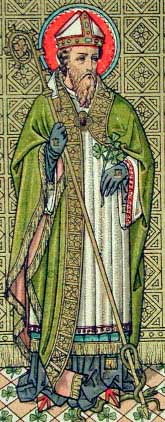
In a notable book on Irish gay history ("Terrible Queer Creatures") Brian Lacey presents some evidence that Patrick may have had a long term intimate relationship with a man:
"St. Patrick himself may have had a relationship tinged with homoeroticism. Tirechan, a late seventh century cleric who wrote about St. Patrick, tells the story of a man Patrick visited and converted to Christianity, who had a son to whom Patrick took a strong liking. Tirechan wrote that "he gave him the name Benignus, because he took Patrick's feet between his hands and would not sleep with his father and mother, but wept unless he would be allowed to sleep with Patrick." Patrick baptized the boy and made him his close lifelong companion, so much so that Benignus succeeded Patrick as bishop of Armagh."
Going backwards in his life, I have seen elsewhere a report* that after his escape from slavery and return to Britain, he supported himself by working for a time as a prostitute - yes, good old Patrick sold sexual favours.
Does this sound far fetched? Not if you consider the historical realities of the time. Patrick's home was in Roman Britain. throughout the Empire, prostitution was an entirely acceptable way for men or women in desperate circumstances to make a living. Consider also his likely experience as a slave. In both Roman and Greek society, as well as elsewhere, it was assumed that one of the duties of a slave, particularly if young or attractive, was to provide sexual services on demand. Ireland was not under Roman rule, but there is no reason to suppose that the conditions of slavery were notably different. (Lacy shows in his book that in pre-christian Ireland same sex relationships were accepted and respected.)
There is another reason, though why we as queer Catholics should look to Patrick as a role model, regardless of his own sexual history, a reason which goes to the heart of his mission.
In "Faith Beyond Resentment", theologian James Alison observes that in the Gospel story of the healing of the man possessed by demons, Jesus instruction to the man after healing was to "Go home," that is, back to the community which had tormented and rejected him, back to his persecutors.
This is what Patrick did. Having escaped from slavery and returned to his original home, he responded to what he saw as a call to return to the country of his captivity, to go back to the land of his tormentors - and convert them.
So he did, and so, I think, must we. Tormented and persecuted we have sometimes (but not always) been by the Catholic Church. Somehow, though, we must find a way to move beyond the anger that provokes, to set aside the resentment, and to "go home to" the church. Thereby we will contribute to its own conversion.
* In a comment to an earlier posting of this piece, theologian JohnMcNeill has said that he thinks the book with this story was "How The Irish Saved Civilization", by Thomas Cahill. "He claims that Patrick paid for his passage back to Ireland by servicing the sailors on the boat."
No comments:
Post a Comment